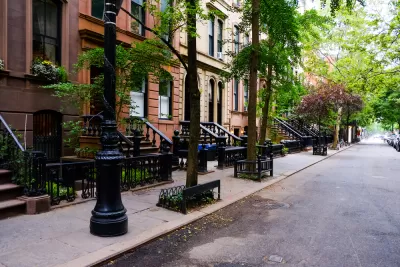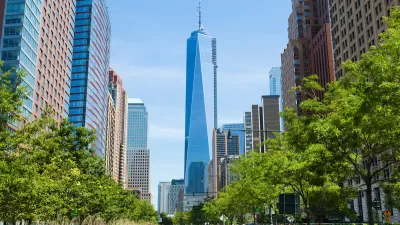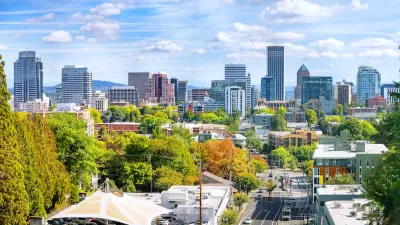A case study provided by the MillionTreesNYC program offers insight into complicated territorial boundaries that can challenge urban greening projects.

An article by Nicole Peterson digs into the results of a recent paper titled "Public Reactions to New Street Tree Planting," examining public relations efforts for the MillionTreesNYC program.
According to Peterson, the key lesson for landscape architects to gain from the study is: "we are often under the impression that because we love urban trees and seeing new trees planted, that everyone around us will love these plantings as well. Some city dwellers do in fact welcome trees with great excitement, but others may see the trees as an intrusion of their private space or territory."
For non-landscape architects and landscape architects alike, the important lesson might also be a central concept employed by Peterson: the sidewalk as a "gray zone" that blurs the line between public and private interests.
According to Peterson, "while the city has legal authority over the sidewalk, responsibility for this zone also lies with citizens. This 'Sidewalk Grey Zone' is one reason the public can have negative reactions to tree plantings. In this example, The City of New York owns the space between the curb and the property line, but the home or business owner is responsible for the maintenance and upkeep of the sidewalk."
As for the findings reported by the paper: the study's researchers "investigated the content of letters, emails, and transcriptions of calls from 311 received by the Parks Department’s Central Forestry and Horticulture Division between 2007 and 2009," according to Peterson's explanation.
"Placement objections" were the largest primary category of complaint (33%), according to Peterson. "Of those complaints, most people were concerned about the disturbance of utility lines."
The evidence of the challenging nature of the sidewalk gray zone, however, was probably most apparent in the category of "policy objections." Of those, 57% "were a general refusal, meaning the resident did not want a tree in front of their property." According to Peterson, "[t]his reaction assumes dissatisfaction with the planting policies and the city exercising its authority over right of way areas. It also indicates how the planting of street trees can evoke issues of territoriality and control."
FULL STORY: The Sidewalk Gray Zone

Maui's Vacation Rental Debate Turns Ugly
Verbal attacks, misinformation campaigns and fistfights plague a high-stakes debate to convert thousands of vacation rentals into long-term housing.

Planetizen Federal Action Tracker
A weekly monitor of how Trump’s orders and actions are impacting planners and planning in America.

In Urban Planning, AI Prompting Could be the New Design Thinking
Creativity has long been key to great urban design. What if we see AI as our new creative partner?

King County Supportive Housing Program Offers Hope for Unhoused Residents
The county is taking a ‘Housing First’ approach that prioritizes getting people into housing, then offering wraparound supportive services.

Researchers Use AI to Get Clearer Picture of US Housing
Analysts are using artificial intelligence to supercharge their research by allowing them to comb through data faster. Though these AI tools can be error prone, they save time and housing researchers are optimistic about the future.

Making Shared Micromobility More Inclusive
Cities and shared mobility system operators can do more to include people with disabilities in planning and operations, per a new report.
Urban Design for Planners 1: Software Tools
This six-course series explores essential urban design concepts using open source software and equips planners with the tools they need to participate fully in the urban design process.
Planning for Universal Design
Learn the tools for implementing Universal Design in planning regulations.
planning NEXT
Appalachian Highlands Housing Partners
Mpact (founded as Rail~Volution)
City of Camden Redevelopment Agency
City of Astoria
City of Portland
City of Laramie




























